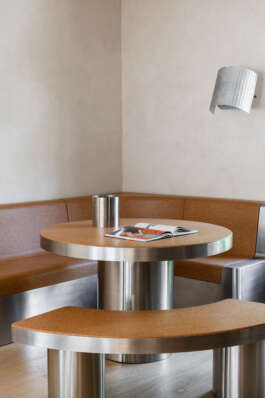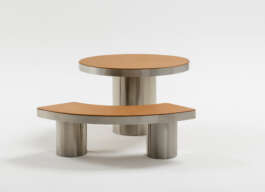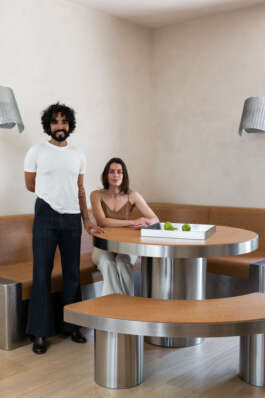



©Ekaterina Izmestieva.
COLLECTIBLE In-Depth
Studio Ahead
August 2025
This series, COLLECTIBLE In-Depth, unveils the backstage of contemporary creation. Tackling various topics from personal designer processes to the position of collectible design on the global design market, COLLECTIBLE In-Depth offers different views to suit all tastes. Today we speak with Studio Ahead.
COLLECTIBLE: Can you talk about a new piece / collection that you release for COLLECTIBLE this year?
Studio Ahead: We are releasing our Cork Collection which includes a table, bench, and stool using stainless steel and regenerative cork from Italy. We started exploring cork for a client that wanted her home to be futuristic and unconventional, but grounded. We had always wanted to work more with molded cork, it has a beautiful sculptural quality and rounds out beautifully. We thought to marry the stainless steel with the molded cork that could act as both the seat cushions because it has a softness and a give to it, as well as the smooth table top - it’s so versatile. The outcome was futuristic and feels timeless.
C: What ethical considerations guide your material choices and sourcing practices in the production of collectible design pieces?
SA: We wanted to work with cork because it can be ethically harvested from tree bark without cutting the tree down. The tree naturally regrows its bark and can continually be re-harvested. With our Sheep Collection we had the same feeling about sheep wool as a material. It is regenerative and we get the wool from ethical herders. Also, all the sheep wool we use is felted by an artisan in Sebastopol using a dry-felting method that doesn’t require any glue, and the sheep wool is the natural color from the sheep. We are always thinking about this with the materials we bring to our collections. Let’s use these soft materials like sheep wool and cork that are sustainable and regenerative. Our challenge as designers is to think of how we use these ethical materials in a sculptural and interesting way for furniture.
C: What tips would you give to a collector who wishes to start collecting contemporary design?
SA: We always tell our clients to start building their ecosystem. Starting going to exhibitions at the museums you’re interested, start finding the art and art furniture galleries that you relate to and get to know the galleries to see what they are exploring. When you really love an artist or maker and are curious to explore their world and have the potential to purchase, commission or be a patron, ask them to do a studio visit and connect with their world.
C: Can you discuss a specific cultural or historical reference that has inspired your recent work in collectible design?
SA: The people that collect, commission, and are patrons to the contemporary world are part of the ecosystem that creates and sustains cultural heritage. Without resources and patrons, artists and makers can’t have the space, time and means to hone their practice. Artists and creatives often have to have second or third jobs to maintain themselves. If we funnel more money towards them, the more freedom they have to create, the more magical and thoughtful the world is going to get.

© Ekaterina Izmestieva.

© Ekaterina Izmestieva.

©Ekaterina Izmestieva.
COLLECTIBLE In-Depth
Studio Ahead
August 2025
This series, COLLECTIBLE In-Depth, unveils the backstage of contemporary creation. Tackling various topics from personal designer processes to the position of collectible design on the global design market, COLLECTIBLE In-Depth offers different views to suit all tastes. Today we speak with Studio Ahead.
COLLECTIBLE: Can you talk about a new piece / collection that you release for COLLECTIBLE this year?
Studio Ahead: We are releasing our Cork Collection which includes a table, bench, and stool using stainless steel and regenerative cork from Italy. We started exploring cork for a client that wanted her home to be futuristic and unconventional, but grounded. We had always wanted to work more with molded cork, it has a beautiful sculptural quality and rounds out beautifully. We thought to marry the stainless steel with the molded cork that could act as both the seat cushions because it has a softness and a give to it, as well as the smooth table top - it’s so versatile. The outcome was futuristic and feels timeless.
C: What ethical considerations guide your material choices and sourcing practices in the production of collectible design pieces?
SA: We wanted to work with cork because it can be ethically harvested from tree bark without cutting the tree down. The tree naturally regrows its bark and can continually be re-harvested. With our Sheep Collection we had the same feeling about sheep wool as a material. It is regenerative and we get the wool from ethical herders. Also, all the sheep wool we use is felted by an artisan in Sebastopol using a dry-felting method that doesn’t require any glue, and the sheep wool is the natural color from the sheep. We are always thinking about this with the materials we bring to our collections. Let’s use these soft materials like sheep wool and cork that are sustainable and regenerative. Our challenge as designers is to think of how we use these ethical materials in a sculptural and interesting way for furniture.
C: What tips would you give to a collector who wishes to start collecting contemporary design?
SA: We always tell our clients to start building their ecosystem. Starting going to exhibitions at the museums you’re interested, start finding the art and art furniture galleries that you relate to and get to know the galleries to see what they are exploring. When you really love an artist or maker and are curious to explore their world and have the potential to purchase, commission or be a patron, ask them to do a studio visit and connect with their world.
C: Can you discuss a specific cultural or historical reference that has inspired your recent work in collectible design?
SA: The people that collect, commission, and are patrons to the contemporary world are part of the ecosystem that creates and sustains cultural heritage. Without resources and patrons, artists and makers can’t have the space, time and means to hone their practice. Artists and creatives often have to have second or third jobs to maintain themselves. If we funnel more money towards them, the more freedom they have to create, the more magical and thoughtful the world is going to get.

© Ekaterina Izmestieva.

© Ekaterina Izmestieva.
Contact
info@collectible.design
VIP PORTAL
EXHIBITOR PORTAL
PRIVACY POLICY
© 2025 Collectible
Contact
info@collectible.design
VIP PORTAL
EXHIBITOR PORTAL
PRIVACY POLICY
© 2025 Collectible